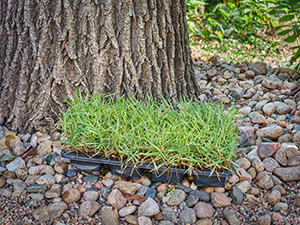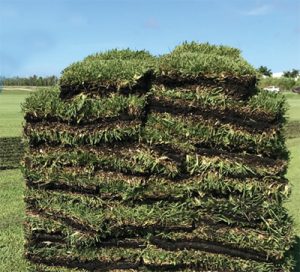Planting Your Florida Lawn

If you’re starting from scratch, there are basically two ways to establish a new lawn: with seeds, or with existing grass (in the form of plugs or sod). While starting with seed is significantly less expensive, it can also be more difficult (especially if you’re the impatient type). Laying sod, large “sheets” of grass, can give you an instant lawn, but it can be expensive. Your method will also depend on the type of turfgrass you choose, as some types can only be laid as seed, and others only as sod or plugs.
Preparing the Site
Preparing the landscape beforehand will make the process go more smoothly. If you’re moving into a new house, remove all construction debris, roots, and rocks from the site. If you’re replacing an existing lawn, you’ll need to treat the area with an herbicide first and remove the dead vegetation.
It’s important to have your soil tested, so that you’ll know the pH and nutrient levels. Your county Extension office can provide you with instructions and the materials to get you started. If necessary, you can add soil amendments and till them in. Finally, be sure the soil is evenly graded and slopes away from the house.
Starting a Lawn with Seed
Seeding is the easiest and cheapest way to establish a new lawn. The best time to seed warm-season grass in most parts of Florida is between April and July, permitting a full growing season before cold weather. Seeding your lawn can be much more cost effective than planting sod, but it depends on which turfgrass you select. Bahiagrass and Bermudagrass are the best choices if you want to start a lawn from seed.
For best results, the site needs to be prepared properly before planting. Make sure you choose high quality seed of a variety appropriate for your area and the site. Remove weeds and vegetation and loosen and level the soil. Work the seed into the soil and cover with sand or another product, such as hay. Seeding rates vary with most species and cultivars of grass. Keep newly seeded areas moist, and apply fertilizer only after the seed begins to grow.
Planting a Lawn with Plugs

Planting a lawn with plugs can be a less expensive alternative to sod, though it doesn’t give the “instant lawn” that sod offers.
You can make your own plugs by cutting sod into two to four inch pieces. You can also buy separated plug trays of certain turfgrass varieties. These commercial plugs usually have well-developed root systems, and they’re often planted with a special plugging tool.
Plant the plugs into prepared soil on six- to twelve-inch centers, taking care to bury the roots. The farther apart your plugs are, the longer they will take to fill in.
Keep plugs watered on a regular basis and don’t mow until firmly rooted. This may take two weeks to a month or more in winter. Don’t fertilize new plugs until they’ve grown together.
Planting a Lawn with Sod

Sodding can give you an “instant lawn,” though it’s costlier than seeding or plugging.
Start by clearing any debris from the site and leveling the soil. When your sod is delivered, check to see that it’s healthy and problem free. Lay your sod within twenty-four hours of delivery, and lightly irrigate the soil just before you begin. Fit the squares tightly against one another in a staggered fashion, cutting them if needed.
Proper watering is essential for your new lawn’s survival. Provide light but frequent waterings for the first two to three weeks, so that the soil stays moist but not overly wet. Once the sod is firmly rooted, you can taper off on watering.
Wait three to four weeks before you mow, and thirty to sixty days before you fertilize.
